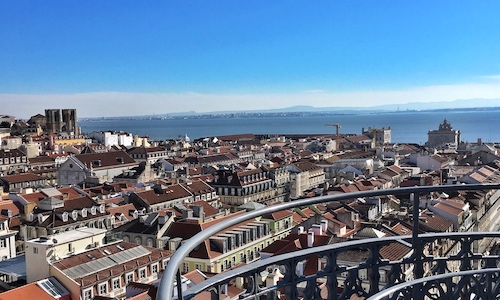When we booked our cheap flight in November, little did we know that 4 days in Lisbon were going to save us from the most freezing Januaries Hungary saw in the last few years. This city break to Portugal came at the perfect moment, and indeed, one of the strongest impressions Lisbon left in our memories is exactly the vivid light and warmth that makes every single step more pleasant.
Interested in more of our efficient itineraries? Find them all here!
Are you looking for more efficient city guides? Here they are!
Do you have more time to spend in Portugal? It’s such a wonderful country! Here’s a great post to learn everything about campervanning in Portugal!
If you don’t have 4 days, check out this complete itinerary for 2 days in Lisbon.
Lisbon: What To Do in 3+1 Days
But let’s be honest, the sun is not enough: what became almost an addiction in only 4 days, the mind-blowing welcome we received at the airport, the first thought as we rolled out of bed in the morning, was… Pasteis de nata, custard tarts! Ooooh my god, in a couple of bites they climbed our ranking of favourite food, and they are still there (definitely in Giulia’s).
DAY ONE: THE CITY CENTRE
As we were hosted by a dear friend a little way outside of the city, we took a bus to reach the city centre. Our exploration started at Marquis do Pombal square, where the wide and majestic Avenida da Liberdade leads down to the central flat neighbourhood of Baixa, surrounded by the hill of Castle and Alfama on the left, and Bairro Alto on the right. We were already captivated by the mosaic decorations on the sidewalks, and Lisbon was just getting started!
After the wavy pattern of beautiful Rossio square (map), the pretty parallel streets of Baixa lead you down to the main square, Praca do Comercio, and to the river Tagus. The sun was finally warming us up, the streets were peaceful, and we kept lifting our gaze to the clear blue sky, to the imposing buildings that rose after the destruction of the 1755 earthquake, to the colorful “azulejo” tiles patterns decorating them.
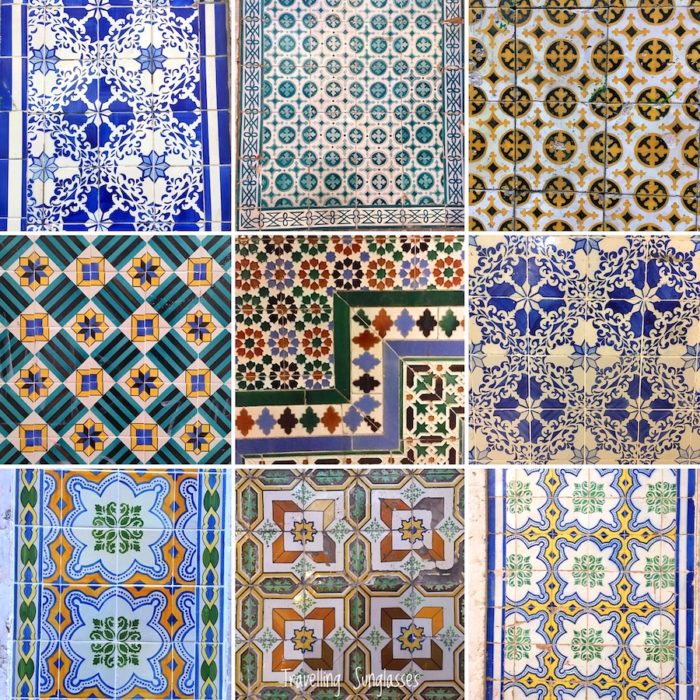
Suddenly, to our right, appeared the Elevador de Santa Justa, the eccentric cast-iron, neo-Gothic elevator that brings up to the Bairro Alto (more about that later!). After a delicious second breakfast of pasteis de nata (and another confusing failed order of espresso macchiato), we passed underneath the triumphal Arco da Rua Augusta and finally opened our gaze to the spacious Praca do Comercio (map), to the river Tagus and the hills beyond. The square is wide and welcoming, classical arcades on three sides and one side totally open to the river, indeed a majestic entrance to the city for travellers arriving by boat in the past centuries, and a real symbol for the reconstruction and rebirth of Portugal after the tragic earthquake. However, I’m sorry for Lisbon, but I (Giulia) was more impressed with Piazza Unitá in Trieste!
We made our way back until the iconic Elevador de Santa Justa (map), and were very pleased to enjoy the discounted ride thanks to our public transportation cards. Even if the 45-meter-high structure is remarkable, don’t get your hopes up: the ride lasts just a few seconds and the wooden panels of the elevator block the view outside, so don’t waste your time in the queue, walk up from the hill side.
The true attraction is the Mirador de Santa Justa, the viewpoint above the elevator, which shows all the city centre, from the Avenida da Liberdade, to Baixa and the Castle Hill, to the river, and a close-up of the ruins of Convento do Carmo on the Bairro Alto hill. With the sun warming up our faces, not too many other travellers competing for the best shots, and gorgeous red-tiles roofs reminding us of Italy, these were a few minutes of absolute bliss!
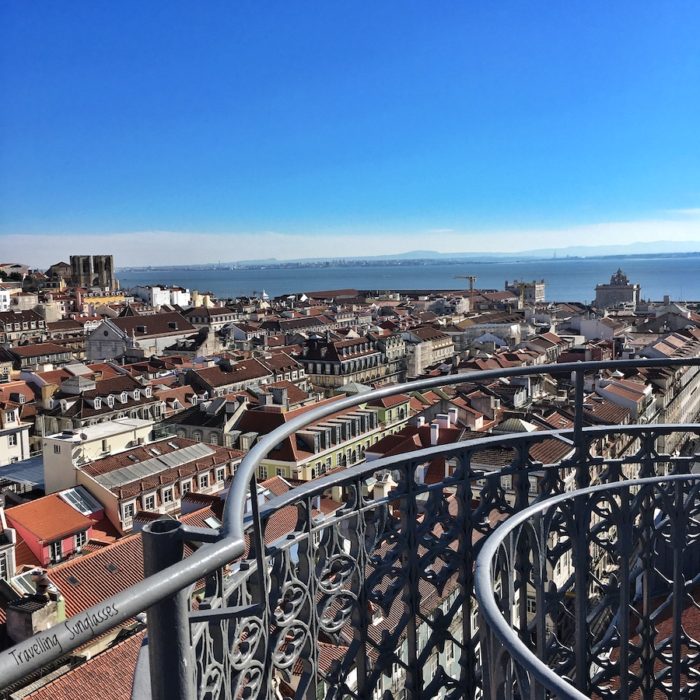
Even though we did not have time to visit the Archeological Museum inside the Convento do Carmo, just walking around the roofless church transmits its impressive strength. The medieval arches stretch up to the clear blue sky above and between them… it is a pure and beautiful sight.
We walked up and down and along the hill of Bairro Alto, had a quick lunch in a “tasca” tavern/restaurant, and headed to Luis de Camoes square (map) for our free tour by Lisbon Chill Out tours.
We were very satisfied: our guide Louis was a great storyteller, so besides telling a lot about the history of Lisbon, of Portugal, of its people and traditions, he kept us focused and engaged at all times. In three hours we walked through Bairro Alto, down through Chiado, to Baixa (must see: the surprising Church of Sao Domingo), across to Alfama by the river, up through narrow alleys to Graca, until gorgeous Miradouro da Graca (aka Miradouro Sophia de Mello Brenyer Andresen, map) and just in time for the sunset. It was amazing, the perfect view of the Castle and Baixa, until the shiny river, the huge 25th of April Bridge and the colorful sky. It was so interesting that we were not even that tired, even though the hills of Lisbon can be quite steep!
Being January, it was already dark by 7ish, so after some wine and a delicious dinner at Casa do Alentejo, we were ready to head to bed.
DAY TWO: BELEM AND PARQUE DAS NACOES
On our second day, we focused on outer districts of Lisbon: Belém to the South-West in the morning, and Park of Nations (Parque das Nacoes) to the North in the afternoon.
As usual, I planned to visit a million places, but overestimated the time available and our speed, but in this specific case we were slowed down by an excellent reason: our first stop was the legendary pastry shop “Antiga Confeitaria de Belém (map)“ . At 10am, we were lucky enough to find a free table and enjoy a cappuccino with warm, deliciously addictive Pasteis de Belém… so much so that we had to have another round!
The whole area of Belem is very well-kept, clean, full of historical monuments, museums and cultural organizations, and of course crowded with buses of tourists and annoying street sellers.
We were very impressed with the imposing Monument to the Discoveries (map) (Padrao dos Descobrimientos), and quite humbled by our ignorance in matter of Portuguese explorers and their achievements. The stone world map decorating the square in front of the Monument is fantastic: drawings of ships around the globe mark the spots that were “discovered” by the Portuguese, a perfect match with the caravel-shaped Monument.
We proceeded along the river to the famous Belem Tower, which is indeed a jewel of white stone, preciously decorated in the intricate Manuelin style with Moorish influence. We walked around it, fascinated by its special position so close to the land, yet surrounded by the water of the river Tagus, but still reachable through a short wooden bridge. The street vendors with scarves and selfie sticks were quite annoying, but luckily they stay close to the entrance of the tower, so we were able to walk away and appreciate this beautiful building.
Never take the same way coming back, right? On the way back to the tram stop, we walked by the inner street to get a good view at the exterior of the Jeronimos Monastery, another example of the complex decorations of the Manuelin style: dozens of statues decorating the gates, each with its own carved pedestal, roof, columns on both sides, and then geometric carvings around the windows, on top of the walls, on the domes… an absolute show of craftsmanship.
We were lucky enough to jump on tram 15 to go back to Praca do Comercio, just in time for our wine tasting at Viniportugal, which we had booked the evening before. It was just the two of us, and a sommelier named Tania guided us through Portugal with 2 white wines and 3 reds, explaining thoroughly the characteristics of the soil, the grapes, the different procedures and ageing techniques. We loved it, and were quite tipsy by the end! Besides Porto (which is a fortified wine anyway) we had tried only red wine from Alentejo region the two nights before, as advised by our local friend, so this was a concentrated, focused and enjoyable solution to taste as many and as consciously as possible. We’ll definitely do it again in other cities 🙂 If you are into wine, you should consider a trip to the wineries of the Douro valley!
By metro, we arrived quite quickly to Estacao do Oriente, The Oriente Station, and to the modern neighbourhood of Park of Nations, built in 1998 for the World Expo, north of the city centre. The Station is an attraction itself, a beautiful piece of modern architecture designed by Calatrava. Even though the interior looks like the works are not finished, from the outside it looks absolutely futuristic, the slender geometric white pillars and beams clearly signed by the famous architect.
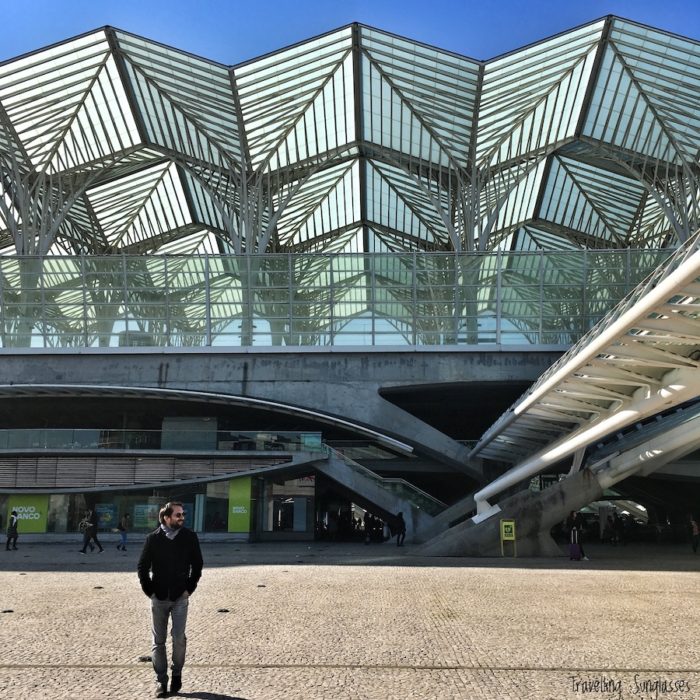
The sun was shining and the riverside was empty and quiet: we admired the modern buildings and public art, walked along the line of flags until the Tagus, where the Vasco Da Gama Brigde shows off its 12,3 km of lenght, reaching gracefully to the other side. The “Teleferico” cable car must be quite entertaining, but instead we opted for some lunch at Peter Café Sport to sober up, and then continued until the Vasco da Gama tower, but unfortunately the roof terrace was closed.
Not quite done with panoramic views, we rushed back to the city centre and quickly walked up Bairro Alto hill, looking for the rooftop bar “Park Bar“, a roof garden located on top of a multi-floor parking (duh). Being January, it was of course closed, but we were still able to enjoy a very picturesque sunset from the floor right below the roof, comprising a glimpse of river, the 25th April Bridge, and a very romantic urban setting of rooftops covering the soft hills. A gorgeous end of the day!
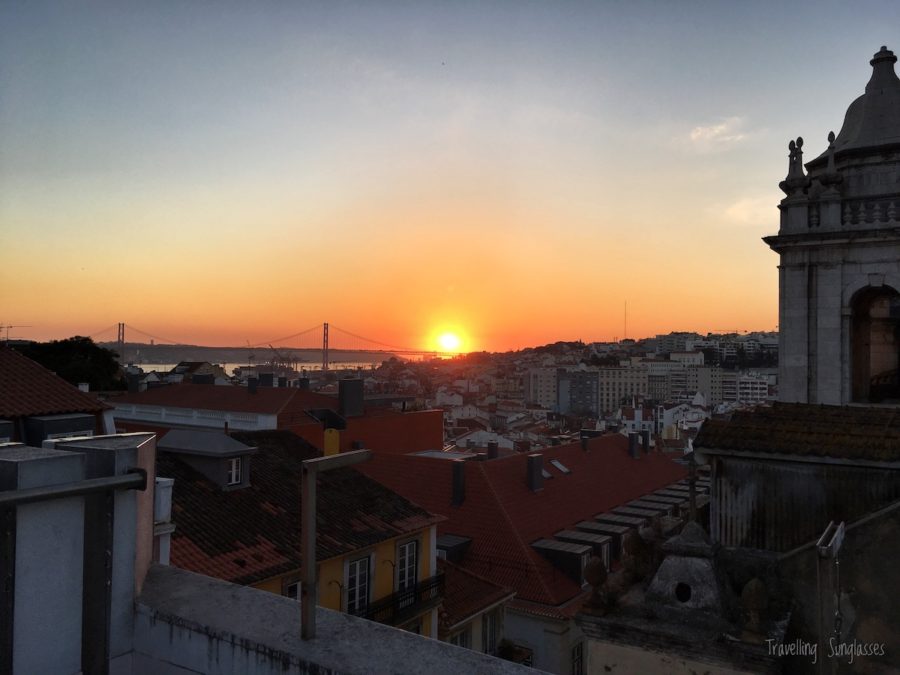
Incredibly, we still had some strength. Nearby, the bookworm in me dragged us to the oldest operating bookshop in the world, the Bertrand Bookshop, established in 1732. It looks quite modern and up-to-date compared to the used books and antique stores nearby, but was still very exciting. I bought a Rough Guide of Lisbon and got it stamped by the cashier on the front page: “Bought in the oldest bookshop in the world!”.
Still not quite hungry and without a destination, we wandered down and across Baixa, and by chance found the coolest city elevator, next to supermarket Pingo Doce, with a gorgeous view from the roof terrace, Miradouro do Chao do Loureiro. We found ourselves in the castle district, so we took our time to admire the strong walls, to wander around the narrow alleys of what feels like a village instead of a neighbourhood of a European capital, appreciating the silence of the evening. We ended up enjoying bread, cheese and wine in a tiny bar called Graca do Vinho, very satisfied of our achievements, and feeling absolutely happy.
DAY THREE: DAY-TRIP TO SINTRA
Our third day deserves a separate post: we went to Sintra, to visit the Palacio da Pena (Pena Palace) and then to the Ocean at Cabo da Roca. What a wonderful day!
THE NIGHTLIFE IN LISBON
For this night only, we had accommodation in the city centre: the Alojamiento SantoTirso was cheap and comfortable, but most of all, the rooftop rooms provides a gorgeous view of Rossio square and of the Castle of Saint George (Castelo de Sao Jorge).
It was time to enjoy the Lisbon nightlife! We chose the Bairro Alto, recommended by friends and locals, the hip and lively area of bars, restaurants and clubs. Our plans to attend a fado concert failed quickly, as every place we passed by was already packed (e.g. Tasca do Chico, recommended by our guide). The warm temperatures brought so many people in the streets, chatting, drinking and smoking, a beautiful mixture of locals, tourists, students and adults, and considering the cheap shots probably a lot of Erasmus students. It was fun just to walk along the narrow alleys, now not only colourful facades and geometric tiles, but also full of life.
We were told that the Pink Street was very lively, but we were hungry! Everything was packed, so we finally chose Artis, where our patient waiting was rewarded by a delicious dinner of local food in petisco size (the Portuguese name for tapas) complete with local wine. Tired, satisfied and tipsy, a great end of the night!
DAY FOUR: IMPROVISATION
Our last day was quite surprising: our friend decided to skip the planned trip to the ocean, so we found ourselves with a whole free afternoon! Darek was very relieved, as I (Giulia) tend to overfill our days with plans.
After more delicious coffee with custard tarts “pasteis de nata”, we took the legendary tram 28. The first one was totally packed, but 30 seconds later another one came, completely empty! Good things come for those who wait 🙂 It was very entertaining to watch the driver turn the big lever-wheel and push buttons as we climbed up the Bairro Alto hill, turned ridiculous corners into narrow alleys, inside this tram with who-knows-how-old wooden benches. Definitely a must!
We had a surprising adventure after waiting way too long for tram 15 to get to Belem: just as another couple arrived to the tram stop and asked how late the tram was – they knew already! – a tuk tuk stopped at the light just next to us. It was the inspiration of the moment: we asked how much for Belem, the other couple agreed, and we all jumped on, in the middle of traffic! We were very squished together on this fun ride, the driver was cracking jokes, and we reached our destination in a flash. Next time, it would be fun to get a whole city tour in a tuk tuk!
We met an old friend of mine at the Cultural Centre of Belem, at the Este Oeste café which has a gorgeous terrace. The sun was shining on the river, highlighting the graceful but imposing Monument to the Discoveries, and small boats were sailing smoothly on the flat water. A real bliss!
Even though there was service in the Jeronimos Monastery (Mosteiro dos Jeronimos), we still lined up to visit the Church, as it was free and the queue was pretty fast. The interior was absolutely majestic, a masterpiece of Manuelin architecture, high and impressive like a gothic cathedral, but white and bright, captivating your gaze with intricate decorations, turning pillars and ceiling into the trees of a forest. It was also pretty exciting to see the monumental tomb of Vasco De Gama, who spent the night in Belem right before setting off to discover the sea route to India!
We couldn’t help but take yet another pack of pasteis de Belem at the original bakery.
From Instagram inspiration, we walked along the river as dark clouds started forming above us, until the MAAT Museum of Art, Architecture and Technology (map) composed of the old, traditional, red-bricks Tejo Power station, and the modern, curvy, white new building. The exhibition inside the MAAT left us a little baffled, but we still enjoyed the futuristic architecture and the way the roof is actually a huge, curvy terrace with stairs starting from the very pavement. So ingenious!
More walking under some drops of rain until the majestic 25th of April bridge, an absolutely massive construction, amazing to look at from below. We weren’t hungry enough to stop at one of the cute restaurants at the Santo Amaro docks, but they sure looked welcoming!
A merciful tram took us back to the city centre, to spend the last hours in Alfama. The atmosphere is so different from any other neighbourhood of the city, just like a village made of narrow alleys, stairways climbing up the hill, neighbours talking from windows and balconies, and graffiti supporting social housing instead of airbnb. I wonder if it would all look like this, if it wasn’t for the earthquake…
We reached the Cathedral, the Sé, a massive Romanesque reminder of how old this city is, and then just relaxed at the most chill café restaurant ever, Cruzes Credo, with wine and good food. Yes, it would have been great to see the ocean again, but Darek was right, some free time to get lost without a plan was just what we needed.
Lisbon went straight into our list of been-there-and-I’d-go-back-right-now cities. It would be amazing to relax a bit more, savour the life, and discover the some more Portugal by car. Everyone has been very kind to us, and we felt safe everywhere. Compared to the very white faces in Budapest, it was very refreshing and exciting to see so many different skin colours in Lisbon, thanks to the immigration from Brazil, Angola, and many other American and African states. It was a truly inspiring trip!
TRAVEL TIPS FOR LISBON:
– Lisbon is extremely photogenic: find here the best photo spots in Lisbon and mark them on your map.
– Get a travel card for public transportation and use it for the “elevador” and “ascensor” lifts and funicular trams to save some hill-climbing
– Try to use the iconic tram 28 on your first day, to have an overview of the city centre
– Book ahead a Fado show, or get reliable advice from locals about where and when to go
– Remember that smoking is allowed in restaurants (as of January 2017)
– Lisbon is all climbing up and down hills. Be prepared with comfortable shoes and lots of energy!
– No need to include breakfast in your accommodation: there are “padaria” bakeries everywhere, the sweet products are cheap and delicious!
– Avoid the sweaty and crowded summer: it’s warm and comfortable even in winter.
Was our story useful to you? Did we miss something memorable? Let us know in the comments!
Cheers!
